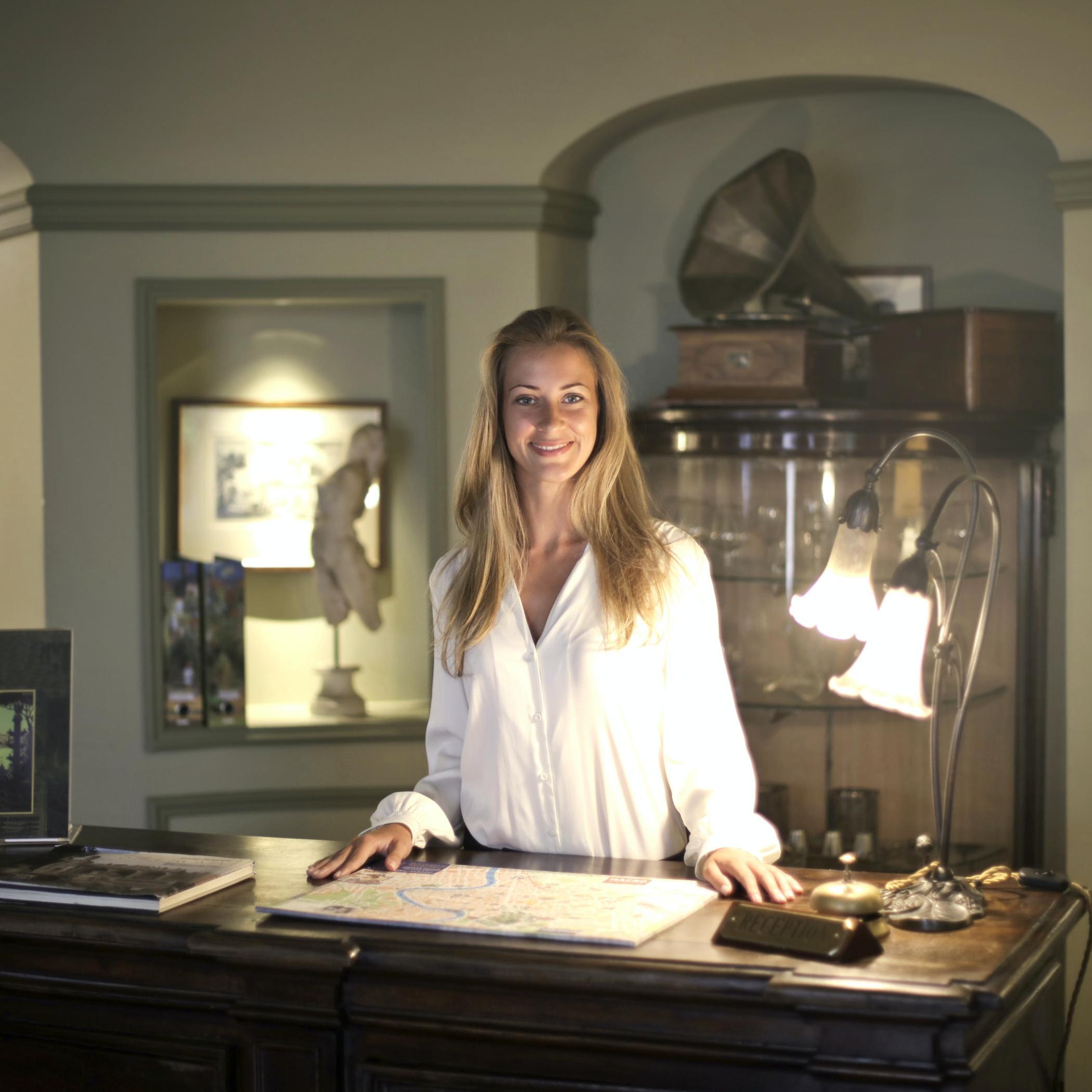A Purpose-Driven Culture Built on Putting People First


Organizations often talk about the importance of company culture, but what does a healthy company culture actually look like? More significantly, how can leaders ensure their company culture is truly making an impact on their people while also benefiting their industries and society at large?
Over the last few years, leaders have been called upon to address the evolving effects of the pandemic on both society and the workplace. People across the workforce have been forced to undergo drastic changes in a short period of time — loss, financial uncertainty, and increased responsibilities at home and work — requiring leaders to pivot and develop new leadership skills and techniques.
More than ever, employees are looking to leadership to meet them where they are, to engage in real conversations, listen, empathize, and be willing to adapt in order to put their people first.
At Banfield Pet Hospital, culture is our top priority. We are the leading provider of preventive veterinary medicine, seeing more than 9.6 million pets a year.As such, our nearly 20,000 employees, who we call associates, are navigating how to balance increased demand for pet care in our hospitals with the challenges brought by the pandemic, professionally and personally.
It’s during these times that leaders are given the opportunity to prove what their culture is made of. For Banfield, the answer is clear: We put our people first.
We established people-first programs and initiatives to enable our associates to have a better, more impactful life while future-proofing our business for long-term growth. In an era of tension and turnover, we were met with increased retention and Banfield grew two times faster than the industry average, enabling the practice to care for more pets and deliver on our purpose — A Better World for Pets — while driving business results.
Ultimately, culture starts at the top. It’s about leading with curiosity, advocacy and impact — all underscored by an urgency to overdeliver, improve the lives of those one is responsible for, and positively impact societal wellbeing. Here are a few ways we go about it.
Meeting people where they are
The key to a positive culture is an open, two-way dialogue rooted in authentic engagement. Associates must feel safe to speak up. As leaders, we must go where the conversation is happening instead of expecting the conversation to come to us.
With the social barrier of working remotely, many leaders are wondering how to engage in conversation-at-scale and connect with a dispersed workforce. This is where leaders must prioritize being agile and using new, creative ways of communicating and reaching our employees — no matter where they are.
As a leader of a company where the workforce is 75 percent millennial and Gen Z professionals, social media has been an invaluable way to meet people where they are and create a safe space for honest discussions. When done correctly, it can empower employees, ensuring that everyone’s voices are heard, and creating conditions in which we can listen, learn and act.
For example, I host sessions I call “Banter with Brian” on my Instagram feed, an Ask Me Anything-style activation where I solicit and answer questions directly from our associates. The ideas, comments, and feedback I hear and then activate on — whether that’s new scrub policy or technology investment — are critical to not only the future success of our practice, but also the continued engagement of our workforce.

Putting advocacy for others at the forefront
Strategy without empathy is a wasted idea. You can have the best strategy in the world, but if your people aren’t behind it, it’s unlikely to have the intended impact.
Taking the time to authentically connect with our people has led to major breakthroughs to help tackle some of the most pressing issues impacting our people, the veterinary profession, and society at large, such as financial debt and mental health and wellbeing.
Veterinarians graduate with the highest debt-to-income ratio of any profession, which was weighing heavily on our associates and holding them back from thriving in their careers. In response, we introduced a Veterinary Student Debt Relief Program, becoming one of just 8 percent of U.S. companies that offer a student debt benefit. To date, we’ve already contributed more than $20 million toward helping our veterinarians pay off student loans.
We also rolled out programs and benefits to give our people tools and resources to help them take care of themselves. These include free access to Headspace, which offers everyday mindfulness and meditation, “ASK – Assess, Support, Know” suicide prevention training, and resources like “Calm the Chaos” conversation guides to ensure we are offering simple practices to support our teams. Additionally, we established Diversity Resource Groups to better understand how we can create a more personalized culture to meet diverse needs.
Putting ambitions into action
Culture of every kind begins with the behavior of leaders. To say that another way, if you are interested in changing the culture of your organization, your first step should be to look in the mirror and make sure you are setting the kind of behavioral example you want everyone else to follow. This means not only fostering the right environment, but also taking actionable steps to invest in your people — and activating your associates to not only improve the workplace but make a lasting, positive impact on society.
By creating an environment at Banfield where our associates feel empowered to candidly share their ideas and feedback through open-way dialogue and conversations at scale, we’ve been able to identify three priority areas to devote considerable resources toward impacting our people, business and society at large: opening educational pathways, elevating mental health and empowering women. We’re calling this effort BANDtogether.
Among these areas, I’m particularly passionate about how we are expanding our educational pathways initiatives. Over the next year, Banfield will commit nearly $10 million toward helping veterinary professionals realize their full potential while creating accessible pathways for individuals that aspire to follow in their footsteps. This includes a partnership with Boys & Girls Clubs of America, a paid internship called NextVet — which gives high school students across the country an immersive, hands-on veterinary experience — and an expanding partnership with InStride.
We’ve been able to help more of our paraprofessional associates get their undergraduate degrees with 100 percent tuition coverage from Banfield through our partnership with InStride. Significantly, we’ve seen a 16 percent increase in retention among program participants compared to non-participants. This program has the dual impact of yielding highly skilled and engaged hospital teams able to provide quality veterinary care to more patients while benefiting our associates’ lives.
The bottom line
Culture is about people. Our people are our most valuable asset, and a business is only as strong as the culture it creates. My why — what fuels my passion — is being able to empower and support the teams that are making a meaningful impact on our clients and communities every day.
Let your people strategy be your business strategy.
This article series is sponsored by Mars and produced by the TriplePundit editorial team.
Images courtesy of Banfield Pet Hospital
Bias in the Hotel Industry Is a Disturbing Wakeup Call


A recent study found evidence of bias in the hospitality industry when researchers emailed 6,000 hotels for restaurant recommendations from email accounts with seemingly "racial" or "ethnic" names. While this won’t be news to BIPOC communities, it does validate what they’ve been saying all along about the insidious nature of everyday discrimination. Likewise, the study should act as a wakeup call for the hotel sector, its management and the service industry in general. Between viral videos, Gen Z’s purpose-driven expectations and so-called cancel culture, a proactive approach to discrimination is more imperative than ever.
This research, conducted by Alexandra Feldberg of Harvard Business School and Tami Kim of the University of Virginia’s Darden School of Business, was carried out between 2016 and 2020. The pair messaged concierges at thousands of hotels around the United States to ask for local restaurant recommendations. They did so from accounts set up to make it appear as though the sender was of a particular race, such as one with the name Mei Chen to evoke an Asian woman, LaToya Washington to evoke a Black woman and Brad Anderson to evoke a white man.
While the response rates were higher for the accounts with the white-sounding names (43 percent) than the Black-sounding names (40 percent) and even more so than the Asian-sounding names (36 percent), the biggest difference was in the quality of the responses. For example, whether or not staff answered with personalized greetings or not varied greatly. Such a greeting went out to perceivably white names almost 75 percent of the time, compared to only 61 percent and 57 percent of the time to perceivably Black and Asian names.
Responses to guys like "Brad Anderson" also included a higher number of recommendations. About 28 percent of responses to white-sounding names gave information in addition to what was asked for in the original email, whereas only 16 percent of those responding to Black-sounding names and 4 percent of those responding to Asian-sounding names sent extra recommendations or information.
As Kim told Harvard Business School: “If hotel managers were only checking response rates, they wouldn’t see any differences in how their service representatives respond to people's emails. Then they might think, ‘Oh, my service representatives are doing great. There's nothing to improve here.’ But what our results are showing is that we need to go beyond that because, even if they are responding to everyone, it doesn't mean that everyone is getting treated equally.”
She and Feldberg did have a few suggestions for the hotel industry, such as surveying a range of different customers to determine if their experiences were of the same quality. Next, they suggested tracking things like greetings and upgrades in order to ensure that guests are getting the same treatment regardless of race. And last, they proposed that hotel management could use a similar methodology as the one in their study to catch bias and provide coaching to staff.
Also of great importance, the study’s authors note that hotel management can create an environment that fosters equity in customer service by setting standards for how employees interact with customers and administer perks. Furthermore, by holding staff accountable for who they give perks to and why, there is a better chance that they will be distributed in an unbiased manner.
Staff composition is of notable importance as well — but it’s no miracle cure. As a 2015 Harvard study on bias in Airbnb bookings discovered, name discrimination occurred even when the host was Black. Still, hiring a diverse staff along with diverse leadership with definitive service protocols in place will go a long way toward remedying the present situation within the hotel industry, Feldberg and Kim said.
Now is the time for hotel management to act. With the advent of live-streaming and apps like TikTok, ignoring discrimination and bias among frontline workers can have devastating effects on businesses that risk getting caught up in a scandal. But it’s not just misbehavior caught on camera that can be problematic. People talk on social media, and they notice when they don’t get the same treatment as others.
Gen Z now makes up roughly 40 percent of U.S. consumers. That’s a big deal considering that they are holding brands to task when it comes to social justice issues. While many are too young to book hotels themselves, they won’t be for long. And those at the older end of the spectrum aren’t likely to treat hotels any differently than other brands. They’d simply rather spend their money somewhere that reflects what matters to them. Hospitality brands that hope to court this target market will have to tackle inherent bias among customer service staff.
Image credit: Andrea Piacquadio via Pexels
ESG Reporting: How Transparent Are You?


ESG reporting laws, as in those monitoring companies' environmental, social and governance performance, are coming.
The U.S. Securities and Exchange Commission (SEC) is working on a new rule that will require U.S.-listed companies to provide investors with detailed disclosures on how climate change could affect their business. Europe recently announced new requirements on how banks report environmental risks and carbon targets.
These proposals are only the tip of the iceberg. Regulators across the world are actively working on new legislation to increase corporate transparency on ESG issues.
It will take time for the regulations to get ironed out – and there still may be no universal measuring stick to evaluate ESG performance. But that doesn’t mean you should sit back and wait. The pressure to be more transparent extends far beyond regulators. Sixty-four percent of consumers say they choose, switch, or avoid brands based on their stance on societal issues. Eighty-five percent of investors consider ESG factors in their investment decisions.
Hone Your Reporting Strategy Now: Now is the time to get a handle on your ESG data. Here are four steps you can take today to get started.
Understand why you’re reporting on ESG: There are a variety of reasons to report on ESG initiatives. Some consider ESG core to their corporate values. Others seek to satisfy investors and shareholders. Still others look at it primarily for risk mitigation. Whatever the reason, understanding the why behind your disclosures will shape your ESG reporting strategy.
Choose the information you will disclose: Focus on ESG metrics that are most meaningful to your priority stakeholders – be that employees, customers, the board, investors, or regulators – and that align with your company’s values and strategy. If your company is committed to environmental stewardship, for example, consider reporting on energy efficiency, air and water pollution, and greenhouse gas emissions. Also consider what others in your industry are reporting to make it easier for stakeholders to compare performance. The next step is to measure ESG performance across your supply chain. No matter what metrics you report on, however, make sure your claims can withstand scrutiny. Expect public declarations to be fact checked more frequently by stakeholders and auditors.
Decide on your reporting frameworks. Nonprofits, business groups and other organizations have created dozens of reporting frameworks to guide companies on what ESG metrics to measure and how to do it. Three popular frameworks include the Global Reporting Initiative (GRI), Value Reporting Foundation (VRF), and Task Force for Climate-related Financial Disclosures (TCFD).
Each group has its own agenda, which means some frameworks focus on environmental metrics, while others focus on social issues. Since no one framework covers all aspects of ESG, many companies decide to pull from several frameworks to create their own. Understand your priorities and incorporate the frameworks that align closest with your objectives.
Leverage technology for an integrated reporting effort. ESG reporting is a complex undertaking that can’t be efficiently managed via spreadsheets. Manually collecting data -- on your carbon footprint and water usage, diversity and inclusion, ethical labor practices, and more – that might reside in many locations across the organization and your supply chain is almost impossible.
Integrated software simplifies data collection and reporting by bringing critical ESG data together in real time. This makes it quick and seamless to build reports, make decisions, and communicate your ESG efforts in a credible and cohesive way.
For effective ESG reporting, double down in 2022: The demand for ESG information is high. Don’t wait for regulations to shake out before getting a solid reporting process in place. Voluntarily reporting on ESG now gives you the opportunity to tell your own ESG story and proactively drive positive change.
Interested in having your voice heard on 3p? Contact us at [email protected] and pitch your idea for a guest article to us.
Image credit: Burst via Pexels
Money Talks: SEC Closes the Door on Climate Change Denial


Environmental organizations and sustainable business groups are greeting the new disclosure rules proposed by the U.S. Securities and Exchange Commission (SEC) with enthusiasm, and for good reason. The proposed SEC rules validate the scientific consensus on climate change on a straightforward, bottom-line platform that leaves no room for doubt, skepticism or conspiracy theorizing. In effect, the proposal invalidates a decades-long effort to obstruct meaningful action on climate change, undertaken by fossil energy stakeholders and their political allies.
Money talks: Climate change is real, says SEC
SEC Chair Gary Gensler explained the proposed climate disclosure rules as an expression of the agency’s foundational mission. In doing so, he threw a giant monkey wrench into the machinery of the climate denial lobby.
“Today, investors representing literally tens of trillions of dollars support climate-related disclosures because they recognize that climate risks can pose significant financial risks to companies, and investors need reliable information about climate risks to make informed investment decisions,” Gensler said in a press statement this week.
"Our core bargain from the 1930s is that investors get to decide which risks to take, as long as public companies provide full and fair disclosure and are truthful in those disclosures,” he further explained.
That reference to the 1930s is a not-so-subtle reminder that the U.S. economy went into the Great Depression at the beginning of that decade, on the heels of a financial catastrophe touched off by the stock market crash of 1929.
As described by the Federal Reserve, a frenzy of speculation during the 1920s preceded the crash, propelled by new financial instruments that enabled everyday people to borrow money to invest. Without a meaningful risk disclosure platform, uninformed investors were almost literally throwing money into a black hole.
Follow the money, follow the science
As the SEC explains, Congress created the agency in 1934 because “our country decided that for capitalism to flourish, we needed to protect investors from fraud and unfair sales practices.”
The SEC also notes that its regulations have kept pace alongside the growth of the financial sector. Although U.S. securities regulations have changed over the years, the two underlying principles have stayed the same since 1934:
- People who seek your investment dollars must tell you the truth about their businesses.
- People who sell securities must treat you fairly and honestly, putting your interests first.
In that context, the proposed rules provide governmental support for the many institutional investors that have followed the facts on climate science in recent years.
The rules also reward the many corporate leaders who have voluntarily pushed the market for renewable energy and other decarbonization technologies, partnered with local and federal decarbonization efforts, and participated in platforms for science based climate disclosures, such as the Science Based Targets initiative.
The new rules also validate the efforts of activist shareholders, who have worked to align stubborn corporate boards with the facts about climate science.
Next steps for climate action
The proposed rules are certain to elicit a storm of protest from fossil energy stakeholders and their allies.
However, they will have to create a new playbook. The denialism of the early 21st century won’t wash in 2022, now that the gears of climate change are fully in motion, just as scientists predicted.
Extreme heat, drought, wildfires, flooding, sea-level rise and damaging storms are never good for business, all the more so when the impacts grow more frequent and intense with every passing year.
The climate denial lobby will also have to reckon with consumer sentiment, which is far more sensitized to environmental issues than in years past.
In addition, the climate denial lobby will have to walk a fine line between defending fossil energy interests and accounting for the impact that Russia’s misbegotten war on Ukraine has had on global energy markets.
Tragically and horrifically, Vladimir Putin’s murderous rampage through Ukraine is yet another demonstration that the global fossil energy economy is inherently insecure and burdened with reputational risk.
Corporate leaders — including several major oil and gas stakeholders — have been quick to exercise their financial muscle to assist in the international effort aimed at pulling the pins out from Russia’s war machinery.
As the comment period for the proposed SEC rules gets under way, the defenders of the fossil energy industry will find that the ground has shifted under their feet. The smart money is on climate science.
Image credit: Kelly M. Lacy via Pexels
Pure Leaf and SeekHer Provide Grants to Women Who Stood Up for Themselves in the Workplace


During the following three years, tea brand Pure Leaf will partner with organizations including the SeekHer Foundation and commit $1 million to organizations and initiatives that support women who have had enough of feeling compelled to do mundane work, coming in on a day off or handling someone else’s tasks.
Why would Pure Leaf get involved in distributing “No” grants? Let’s set the context.
Women are still falling behind in the job market
The Bureau of Labor Statistics’ February 2022 jobs report delivered good news about progress toward reaching pre-pandemic employment levels, but that goalpost still has 1.14 million jobs to go to be reached. One obvious way to fill that gap is to get the remaining 1.1 million women who lost jobs or continue to leave — including 31,000 Black women last month — to return to work.
The problem is not a lack of work ethic on women’s part; in fact, the opposite holds true.
The pandemic hit mothers in the workplace hard, whether single or married. Childrearing and schooling in the home fell mostly on them as work came home or jobs were lost and as daycares and schools closed down.
A culture of fear over setting limits and saying 'no'
For employed women without children, also both married and single, horror stories abound: 20-hour workdays, juggling the caregiving to parents or ill partners, and demands for being the emotional and work support to others 24/7. “Superwoman syndrome” is real and becomes a vicious cycle of external social and work pressure combined with internal expectations.
The findings of a recent SeekHer study bear out these mental health issues confronting women in the U.S. and globally. Women often put the needs of others first, feel guilty for engaging in self-care, and experience fear or discomfort with their work environments.
To that last point, the study found that only about 32 percent of women felt their workplace was open to discussing personal and professional needs. Not only do companies fail to provide this safe space, according to women’s perceptions, but businesses often exact punishment for women saying “no” to work demands.
To quantify what saying “no” means for women in the workplace, Pure Leaf Iced Tea, which launched its “No Is Beautiful” campaign in 2020, surveyed 1,800 U.S. women in November 2021. Its research found that three-quarters of the women expected negative consequences for saying “no” at work and that nearly 2 out of 3 actually experience that negativity.
Further, the study assessed that saying “no” had actual costs in future earnings. For white women, it translates to $731 per incident. Racial discrimination adds to the toxic work stew, as each incident costs Asian-American women $871, Hispanic women $1,403 and Black women $1,406.
Pure Leaf and SeekHer step up for women
To that end, Pure Leaf and SeekHer recently launched part of the overall initiative, which features Olympic champion Allyson Felix, to provide $2,000 “No Grants” to 100 individual women who have been adversely affected by standing up for themselves at work.
Beyond her athletic accomplishments, Felix gained widespread attention for the split she and Nike had over the issue of women athletes becoming pregnant. Nike later altered its policy. Felix moved to Athleta and then achieved Olympic gold again, running in shoes from her own line, Saysh.
The problem of saying “no” pre-dates the pandemic, of course. One study found that women accept or volunteer for low-promotability tasks more often (76 percent) than men (51 percent). Because women do so — whether out of fear of negative consequences, a desire for social acceptance, altruism or other motivator — both men and women are more likely to ask women to perform a low-status task.
This creates yet another vicious cycle that is disadvantageous to women.
Business leaders can turn such interactions into better outcomes for women in simple but effective ways. For example, assigning low-promotability tasks equitably removes employee discretion in accepting or declining a request.
Alternatively, tasks can be weighted with value, so they lead to promotion or are paired with other incentives, such as bonuses or time off. Even just setting guidelines applicable to everyone on how and when to say “no” improves the cultural environment in support of women’s mental health.
One more “atta-girl” for serving on one more committee isn’t going to draw women back to the workplace or compensate companies for lost productivity due to their absence. To borrow from the immortal words of vaudeville:
No applause — just throw solutions.
Image credit: Naassom Azevedo via Unsplash
LA-Based Company Raises the Bar High for a Closed-Loop Apparel Standard


Everywhere Apparel recently launched what it says is the world’s first closed-loop blank apparel (defined as clothing without any decorations or branding) line made of 100 percent GRS-certified (Global Recycled Standard) cotton. This Los Angeles-based clothing company is providing an alternative to recycled polyester (rPET) with Circot yarn and fabric. This fiber is fully recycled and free of microplastics, unlike other fibers on the market. Founded in 2019, the company is led by Stanford-educated engineers with an objective to transform the materials industry with more sustainable materials.
The company decided to open-source its closed-loop system at no cost in order to make the technology accessible to anyone interested. Centering its focus on blank apparel, Everywhere Apparel is increasing its impact on sustainable fashion by broadening its reach as wide as possible. Printable clothing appeals to the business-to-business, or B2B, market by reaching other organizations. Everywhere Apparel goes beyond individual consumers, providing other businesses a simple catalyst toward showcasing their focus on sustainability through distributing branded apparel.
What sets Circot fabrics apart?
Everywhere Apparel utilizes Circot yarn, which is fully recycled. According to the company, its closed-loop, 100 percent recycled cotton garments have a far lower environmental impact than organic cotton and recycled polyester. Circot is spun out of shredded recycled cotton fibers and knitted into a fabric that is both durable and comfortable. Other brands can then purchase the garments and have their preferred designs printed on them. This process appeals to companies that are motivated to reduce their carbon footprints.
According to Everywhere Apparel, the lifespan of its shirts is a few years. Once the shirts are no longer wanted, the owner scans the QR code on the tag to order a free return envelope.
How this closed-loop apparel manufacturing process works
Everywhere Apparel says it accepts heavily worn garments, as well as garment scraps. The company will also accept other used clothing in consumers’ closets, adding it to the collection of recycled cotton fiber to be spun into Circot yarn. Upon receipt, the shirts and scraps are organized by color and then mechanically shredded to begin the cycle once again. Contributing to this closed-loop process also earns consumers a $10 credit towards more closed-loop recycled products.
Using Circot fabric to manufacture garments offers several significant advantages. Everywhere Apparel says that no water, dyes, microplastics or chemicals are used in, or linked to, its fiber production. Additionally, closed-loop garments help direct waste away from landfills as well as give companies another tool to reduce their carbon footprints.
“Mechanically recycled cotton is the most sustainable apparel fiber in the world along multiple measures when compared to conventional or organic cotton and recycled or virgin polyester,” Everywhere Apparel said in a public statement earlier this month.
Why strive for sustainability in the apparel industry?
With roughly 85 percent, or 3.8 billion pounds, of the clothing Americans purchase send to landfills as solid waste, the apparel industry is a large contributor to pollution worldwide. Hence Everywhere Apparel is pioneering a more responsible future for this sector. Beyond leaving a smaller impact on the planet as well as wishing to mitigate any effects on people and the planet, consumers are strongly motivated by sustainability when it comes to where their dollars go.
According Everywhere Apparel's data, 81 percent of people feel strongly that companies should help improve the environment, and 75 percent of them view sustainability as either extremely or very important. Further, 70 percent of consumers think it is important that a brand is sustainable or eco-friendly. Practicing and promoting sustainable initiatives internally can make a brand more attractive to consumers and thereby increase profits.
Other brands have also adopted a closed-loop model, keeping clothing in circulation for as long possible. Companies like Evrnu, Worn Again Technologies, and For Days are making it possible for brands and individuals to curb clothing waste. Everywhere Apparel, along with the aforementioned apparel brands, are closing the loop, reducing microplastic deposits, saving water and directing waste away from landfills. A new system for purchasing and discarding clothing is finally emerging.
Image credit: Chase Charaba via Unsplash
Some Companies’ Reputations at Risk as Russian War Atrocities Mount


The Russian war against Ukraine sparked an unprecedented backlash from U.S. and global corporations. Scores of the most recognized brands in the world dropped all or part of their business ties with the country soon after it launched a murderous, unprovoked attack on Ukraine. Those remaining have struggled to justify staying, though clearly, they should make a clean break. Among other reputational risks, they stand to lose all credibility on how they stand on racial equality, gender diversity and LGBTQ rights.
Unprecedented unity on sanctions
Global fossil energy companies were among the first to announce the suspension of business in Russia, even before governmental sanctions regimen got under way. Many other companies soon followed, amplifying the impact of international economic sanctions.
In addition to pulling out of Russia, many companies have also rushed to provide humanitarian and defensive aid to Ukraine. In particular, leading U.S. tech companies responded to a direct appeal from the Ukraine government to apply their systems and equipment to the defensive effort. That includes Elon Musk’s Starlink communications venture. Though security experts initially cautioned that the system could enable attackers to find targets, the equipment has reportedly been helpful.
Who is defying demands to exit?
All in all, the business response to Russia’s unprovoked attack on Ukraine is unprecedented in terms of scale and unity. Still, there are some notable holdouts.
Editor's note: Be sure to subscribe to our Brands Taking Stands newsletter, which comes out every Wednesday.
The Yale School of Management has been tracking the corporate response in the form of a downloadable Excel list. The list is divided into five categories in descending order of impact. To date it includes more than 400 companies. Of those, an impressive number of 166 are making a permanent or “clean break.” Another 186 are suspending operations, which is also a forceful act. A lesser number are taking more limited action, with 28 scaling back operations, and 54 delaying future plans while continuing existing operations.
The fifth category, as of press time, consists of 32 companies that have been unresponsive to the rising tide of public and government sentiment. The school lists this category as “digging in,” defined as “companies defying demands for exit/reduction of activities.”
The key word is action. Through the “digging in” category, Yale draws attention to a shrinking number of companies that have taken no public action at all.
Other familiar names in the “digging in” category include Ball Corporation, Cloudflare, Credit Suisse, International Paper and Renault.
Brand reputation at risk when companies appear to overlook suffering
At this time, much of the public pressure has focused on two very different companies that do have one thing in common, and that is their high public profile. One of them is Koch, which Yale lists in the “digging in” category. The other is Nestlé, which is among those companies “buying time.”
Koch and Nestlé are not alone. Other global companies have taken some action but have also failed to break or suspend all operations. By staying, they have all exposed themselves to a reputational risk that will take years, if ever, to resolve.
Nestlé has put itself in the position of appearing to critics as overlooking Russia’s wanton destruction of residential buildings, schools, hospitals, care homes, hospitals and bomb shelters. Short of genocide, those actions have all the hallmarks of a terror campaign aimed at depopulating Ukraine, no matter the human cost.
That puts Nestlé squarely in the spotlight due to its oversized role in the global food supply chain. In a statement dated March 11, Nestlé insisted that has a responsibility to continue supplying essential foods and medical products in Russia. The forced displacement of millions and the bombing of civilian populations clearly undercuts that argument.
Nevertheless, as recently as March 21, the company persisted in defending its decision in terms of its responsibility to employees in Russia as well as its role as an essential food supplier.
Similarly, as of last week Koch inferred that its 600 workers in Russia will suffer if the company shuts down its two glass factories there. Meanwhile, news reports continue to show the millions suffering, dying and losing their jobs in Ukraine.
The diversity factor and the Russian war
The element of human suffering alone should drive the corporate response to the Russian war on Ukraine. However, Koch and Nestlé also illustrate how some companies also continue to put themselves at reputational risk as a matter of corporate social policy.
Stephanie Foggett, Mollie Saltskog and Colin Clarke of the counter-terrorism and security consultancy Soufan Group have drawn attention to the role of “tactical misogyny” in both Russian aggression and the far-right extremist and white supremacists movements in the U.S. and elsewhere.
They outlined their case last week, in an article published on the War on the Rocks online platform, a project of the firm Metamorphic Media.
Though cautioning that the far-right response to Russian aggression is complex and varied, they argue that the common denominator is “the creation of a white ethno-state and the destruction of Western liberal societies.”
That puts Russia’s attack on Ukraine in perspective as a matter of corporate social policy.
"The false ‘evidence’ levied against [Ukraine President Volodymyr] Zelenskyy includes the fact that he is Jewish — and thus part of the ‘global elite’ — and that he is a supporter of rights for the LGBTQ+ community, who the Kremlin claims seek to exploit children in order to groom them,” the three researchers explain. The latter narrative shows alignment with far-right extremist groups such as the Proud Boys, which frequently deploy homophobia and anti-LGBTQ+ rhetoric within their propaganda.
In short, companies that continue to maintain a footprint of any sort in Russia are aligning themselves with the world view of murderous extremists, a position that runs directly counter to the kind of support for gender diversity and LGBTQ rights that companies like Nestlé claim as part of their corporate identity.
"For years, Putin’s sexist rhetoric and deliberately cultivated macho imagery have played into the hands of white supremacist extremists who share his disdain for women and gender equality,” Soufan’s researchers write.
They also note that white supremacists in the U.S. commonly claim that the U.S. military is being “destroyed by diversity,” and that “in meeting the needs of women, minorities, and gender non-conforming servicemembers, Western militaries were lowering standards and fighting fitness."
Under the spotlight as sanctions mount
The “destroyed by diversity” world view made its way into White House policy in stark relief during the run-up to the 2020 presidential election, when former President Donald Trump lead the charge to brand diversity training as a sort of 21st-century red scare.
On September 22, 2020, Trump issued an executive order that banned certain types of diversity training among all federal agencies and their contractors, including the U.S. Department of Defense.
Unlike Nestlé, Koch is not widely known for a focus on gender equality and LGBTQ rights. However, the September 22 executive order underscores the company’s ties to steering public policy. Aside from their well-documented support for fossil energy stakeholders, the decades-long role of the Koch family in promoting right-wing policies is an attention-getter that extends from the John Birch Society in the 1960s on up to the present day. That includes financial support for the Federalist Society, which was instrumental in seating three conservative Supreme Court judges during Trump’s term in office.
Given this background, it is no surprise that Koch has become a focus of attention as sanctions against the Russian war effort mount. The company argues that its operations in Russia are limited to the two glass factories, but last week independent journalist Judd Legum of Popular Information detailed how groups backed by Charles Koch have launched a lobbying effort against the sanctions.
It’s also no surprise that the full weight of a decades-long campaign against civil and human rights in the U.S. has taken the precise form of the Putin world view outlined by the Soufan Group researchers, focusing like a laser against women, against transgender children and against diversity education in elementary schools, and it is no surprise that the first Black woman to be nominated to the Supreme Court is met with a whisper campaign that raises the same child-centered canard long wielded against Jews.
As the atrocities pile up in Ukraine, corporations that take their human and civil rights profile seriously need to take a long, hard look at their support for elected officials in the U.S., who promote the same world view practiced to the lethal, near-genocidal consequence by Vladimir Putin’s forces in Russia.
Image credit: Gayatri Malhotra via Unsplash
The Microplastics Crisis is Getting Worse. Can California’s Plan Move the Needle Forward?


Straws turn are among the single-use plastic items that can become microplastics
With more than 11 million metric tons of plastic entering Earth’s oceans every year, an amount experts say could triple by 2040, California’s comprehensive plan to reduce microplastics may very well serve as a welcome push. Will it be enough to make a difference? The scale of the microplastic pollution generated within the world’s fifth-largest economy alone indicates such a strategy certainly could not hurt.
“We must take action, and this strategy shows us how,” said Wade Crowfoot, the state’s secretary of natural resources, in a public statement announcing the plan. “By reducing pollution at its source, we safeguard the health of our rivers, wetlands and oceans, and protect all of the people and nature that depends on these waters.”
Research has suggested that the Golden State’s waterways are saturated with microplastics. The effects include “an estimated seven trillion pieces in San Francisco Bay alone, much of which washes in through stormwater drains,” Katherine Gammon of the Guardian reported. On that point, the California Ocean Protection Council (OCP) identified the top sources of microplastics: tires, synthetic fabrics (often from fragments that can be sourced to washing machines and dryers), cigarette filters and single-use plastic food containers.
The Golden State’s two-track plan was announced in late February. The plan’s first track lists 22 immediate, “no regrets” actions to curb plastic pollution at its sources, find ways to reduce and manage microplastic pollution, and educate the public about the problem while offering the best possible solutions. The second track outlines a 13-point comprehensive research strategy to enhance the scientific understanding of the sources of microplastics in California, drive future action through a statewide monitoring plan, boost the knowledge of how these pollutants can affect aquatic life and human health, and then, develop a future management plan for microplastics based on locally available data.
Organizations including the United Nations Environment Program (UNEP) have concluded that plastics are the most harmful and persistent fraction of marine litter, accounting for at least 85 percent of the waste that ends up in the globe’s waterways and oceans. Microplastics, which agencies including the National Oceanic and Atmospheric Association (NOAA) identify as plastic particles less than five millimeters in size, are the result of plastics in aquatic environments breaking down into pieces of ever-decreasing size. According to agencies including the IUCN as well as OCP, the potential health effects on marine life include tissue inflammation, impaired growth and development as well as the impaired ability for such species to reproduce.
Preventative measures in California’s plan range from a ban on certain plastic materials, prioritizing the reusability of packaging, limiting single-use plastic, a plan for statewide procurement of reusable food-ware, and stopping the sale and distribution of polystyrene-based food containers and packaging by 2023.
Andrew Gray, a watershed hydrologist at the University of California, Riverside, told Guardian the plan’s emphasis on prevention is critical, as once microplastics are in the environment, removing them is “virtually impossible.” Gray leads a research laboratory at UC-Riverside that contributed some of the science that helped develop California’s microplastics plan.
The global pandemic made plastic pollution worse due to the increased demand for single-use plastics, intensifying pressure on the environment, according to research published by the U.S.-based Proceedings of the National Academy of Sciences (PNAS) last fall. More than eight million tons of pandemic-associated plastic waste have been generated globally, and more than 25,000 tons – mostly medical waste from hospitals – entered the oceans, concluded PNAS’s researchers.
In addition, legislation aimed at curbing plastic pollution was postponed in California and other U.S. states. This November, California’s voters will vote on a ballot measure that would require all single-use plastic packaging, containers and utensils to be reusable, recyclable or compostable by 2030.
California’s plan could provide a roadmap for a global community becoming more aware of the threat posed by plastic waste. Some companies, such as Coca-Cola, have responded to public pressure by announcing plans to increase the amount reusable packaging for its products. In early March, as evidence mounted that more citizens worldwide support some form of a ban on single-use plastics, representatives from 173 countries met at the United Nations Environment Assembly in Nairobi, Kenya to agree on continuing talks over the next two years for a global treaty that will address plastic pollution.
For many scientists, such a global treaty could not come soon enough.
“The exponential rate at which global industries extract fossil fuels and produce new plastics and associated chemicals outstrips governments’ ability to regulate their safety, manage waste, and mitigate harm to people and the environment,” a team of scientists led by Bethanie Carney Almroth, Melanie Bergmann and Scott Coffin wrote in an op-ed for Environmental Health News. “The total mass of plastics produced exceeds both the overall mass of all land and marine animals and the planetary boundary for these novel substances, moving us out of a safe operating space for humanity.”
Image credit: FLY:D via Unsplash
Forget the Great Resignation, Let’s Talk About the Great Reengagement


Few companies have avoided the drain on talent brought on by the oft-cited Great Resignation. Most corporate executives are scrambling to identify flexible working models that are attractive to current and prospective employees, while still aligning with bottom-line results. While the mobility of talent has forced companies to consider and implement flexible working environments that prioritize the remote model, this workplace flexibility has quickly become table stakes among the most competitive magnets for talent.
Just as ping-pong tables and beer carts were once differentiators for what became the mislabeled definition of “tech culture” five to 10 years ago, we’re now seeing companies lean on workplace flexibility as the defining characteristic of what makes their company special. And while this flexibility is certainly a strong benefit, it’s now expected and no longer enough to differentiate a company. Additionally, while a flexible working model appeals primarily to one’s sense of convenience and personal preference, it fails to fully capture what motivates the purpose-driven employee.
And so, as millions of square feet of office space designed to attract employees remain largely empty, how can mission-driven companies ensure they retain their culture, leverage in-person connections, and reinforce their collective purpose? The answer lies at the heart of attracting and retaining the purpose-driven employee, and it’s something that is needed now more than ever: volunteering and community engagement.
Ignite the connection between employees and their communities
A recent study found that nearly 70 percent of employees would refuse to work for a company that lacks a clear sense of purpose. A commitment to corporate social responsibility (CSR), for example, is a prime example of an organization’s underlying purpose. The personal connection between a company and an employee’s purpose and values is critical to maintaining employee engagement. Unfortunately, in the absence of in-person volunteering engagements amidst the pandemic, the personal connection between employees and the community diminished greatly. CSR programs largely have been reduced to writing checks and occasionally holding vaguely engaging volunteer events on Zoom.
Just as our in-person work muscles have atrophied over the past two years, so too has our ability and willingness to volunteer in person with charitable partners. A 2020 study by Fidelity Charitable found that two-thirds of regular volunteers decreased or stopped volunteering entirely amidst the pandemic.
Many in the workforce have attempted to restore normalcy in their lives. Their kids are back in school, and they’re going to the gym, restaurants and grocery stores. Reintroducing in-person community engagement is not only an important next step in re-engaging employees, but it’s also an increasingly realistic and valuable activity for them to safely partake in.
In place of mandatory in-office requirements, in-person volunteering presents a unique opportunity to bring employees together, restore a sense of collaboration and community, and further strengthen corporate culture. Despite the recent surge of omicron and the specter of future coronavirus variants, there is a broad need to restore work cultures and return to a version of normalcy wherever possible. Engaging with community partners who have suffered in a remote-first world is a critical piece of more creative in-person interactions, while driving meaningful engagement touchpoints between employees and their communities.
Volunteering brings benefits across the board
Make no mistake, volunteering may never look the same, but most nonprofits actually may be better for it. COVID-19 and our subsequent reluctance to gather in crowds may have thankfully ended the days of hundreds of T-shirt clad employees descending on a nonprofit for service days that too often end up leaving the nonprofit overwhelmed and underprepared. Instead, we’re seeing a shift in volunteering that focuses on small-scale and often one-on-one engagements. This intimate approach leads to more engaged employees, more meaningful results, and interpersonal relationships that rarely occur at those large-scale, single-day playground cleanups.
The benefits felt are not limited to the partner organizations. Volunteering gives companies an in-person touchpoint to bring their employees back together without the complexity and sensitivity that comes with mandating a return to the office. For employees not quite ready to head back to the office regularly, volunteering provides an opportunity for colleagues to connect in person, reconnect with their corporate mission, and engage with community partners who’ve largely been unable to organize in-person experiences up until now. At a recent volunteer event with three of my colleagues whom I’ve barely seen since early 2020, we spent the entire session chatting and catching up with one another while sorting winter boots for children. We left feeling like we made a small difference, but we also took a big step in rebuilding relationships that have been relegated to a computer screen for the past two years.
Volunteering is the ideal vehicle to solidify our commitment to the community, bring employees back together, and remind them of the central role that social impact and community resilience play in our values and our business model. Best of all, this effort, amidst a highly competitive talent landscape, will attract a new crop of engaged and purpose-driven employees.
Interested in having your voice heard on 3p? Contact us at [email protected] and pitch your idea for a guest article to us.
Image credit: RODNAE Productions/Pexels
What’s Next for LanzaTech, the Carbon Capture Company Going Public?


LanzaTech, which recycles carbon emissions into fuels and textiles, recently announced that it will merge with AMCI Acquisition Corp. II in a SPAC deal, valued at $2.2 billion, to become a publicly traded company. The deal is expected to close in the third quarter of 2022.
TriplePundit recently spoke with LanzaTech CEO Dr. Jennifer Holmgren about what brought the carbon emissions recycling company to this moment, how her team is closing supply chain loops for a more circular, “carbon-smart” economy, and what LanzaTech has planned for the future.
‘It’s time’ for LanzaTech, for the economy and for the climate crisis
LanzaTech is based in Skokie, Illinois, and works with partners around the world, including in Japan, China and India. During the last few years, the 17-year-old company has achieved proof of concept for how its gas fermentation process can create “a future where consumers are not dependent on virgin fossil feedstocks for everything in our daily lives.”
The company’s plants feature bioreactors where microbes use waste carbon monoxide and carbon dioxide, siphoned from steel mills or captured from municipal solid waste, to make a proprietary blend of ethanol it brands as Lanzanol. Ethanol is a basic building block of many materials, and LanzaTech and partners have already leveraged it to make sustainable jet fuel a reality and put renewable yoga pants on the market.
“It’s really been a case of convincing people what’s possible,” Holmgren said of the company’s business model. “Our technology is one platform that we’ve optimized. [Our goal was] to convince people we’ve got your feedstock for production of consumer-grade materials, and that we’ve made it from waste.”
Holmgren said she is excited about the visibility going public will bring LanzaTech now that it has shown how its technology can work at scale. The company has two commercial plants with bioreactors and another seven in the pipeline. “We’ve been much more methodical than other companies in our sector that went public before they got their first commercial plant running,” Holmgren told 3p. “We need to step up. It’s time.”
What’s next for LanzaTech
As the no-nonsense message on LanzaTech’s website states: “It’s not a debate. There’s no two sides. A post-pollution world is inevitable. Humans will either be part of it, or the planet will go on without us. But where others see a dire choice, LanzaTech sees a trillion-dollar opportunity.”
Holmgren believes LanzaTech’s model presents a win-win solution that addresses the shortcomings of our consumption-fueled capitalist economy, which she said is badly “in need of climate justice," and gives hope “to those who understand just how bad the climate crisis really is.”
“The future is not obscene capitalism," she added. "If I can convince people that you can make money while reducing carbon emissions, I think that helps a lot.”
To that end, the company will start building out the “portfolio of molecules” at its disposal by genetically modifying ethanol. For example, Holmgren said, “instead of just making polyethylene, we can make polypropylene. Instead of making polyester, we can make acrylic.”
Right now, LanzaTech is working to make acetone and isopropanol, which should be ready in 2023.
It takes a village (of people and microbes)
Holmgren, who was recently named one of 25 leading women shaping climate action and who was previously named the world’s most compassionate businesswoman, puts a lot of stock in collaboration. “Doing hard things can’t only be done by an individual or a company. It has to be done by a consortium of partners," she told us.
Because the SPAC deal was announced on March 8, International Women’s Day, we asked Holmgren how it feels to helm LanzaTech as a CEO who happens to be a woman.
“Every time I sit at a table, I have to prove myself,” she acknowledged. “When it comes to the phrase ‘woman CEO,’ I have to totally forget about it so it doesn’t bog me down.”
Instead, Holmgren prefers to focus on the current moment. “I’m leading a transformative company in an industry that needs to be transformed. The carbon economy needs to be transformed. We’re ready to step up into the light and show people what is possible.”
And within the company, Holmgren doesn’t want the larger implications of LanzaTech's work for people and planet to be lost. “Our company culture is about not just doing good but being good citizens,” she said.
As of 2022, LanzaTech’s plants have produced over 30 million gallons of ethanol, the equivalent of offsetting 150,000 metric tons of CO2 in the atmosphere. Not only does the process convert more than 90 percent of the carbon in CO2 gas streams into ethanol, but the company says its systems also recycle over 90 percent of the water they use and utilize the spent bacterial biomass as a nutrition source for aquaculture.
Image credit: LanzaTech Investor Relations